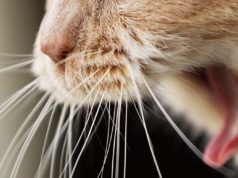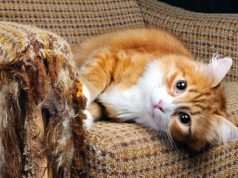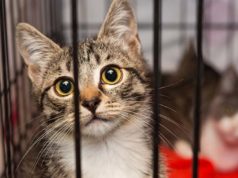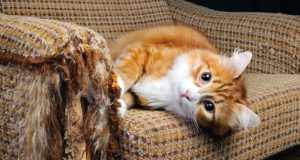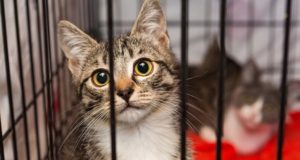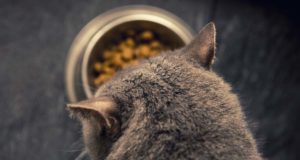Your cat talks to you whether you’re aware of it or not. Our felines communicate with us through mmrps, purrs and meows, but most of all through cat body language. Because a cat’s body is expressive and flexible, the feline can speak to you in movements to get the point across.
Many of the cat’s body language choices and movements your cat makes are some form of communication. If you understand the cat body language, you may be able to care for her better, understand cat’s needs as well as talk “cat” to her (in a way).
There are few well-known cat body language moves that everybody understands, but not completely. For example, when a cat gives you a face rub or butts you with her head, she’s doing more than just saying hello. This is because a cat has scent glands on the top of the head between the ears, between the cat’s eyes and on the upper lip and chin.

The rub or head butt by your cat leaves a scent that tells other felines (and you) that your cat is claiming ownership of you. Or that it’s happy to be on your lap, bonding with you. But it can also mean she’s been ticked off so you need to judge your cat’s mood too.
In addition, cat’s scent gland on your her paws leave a scent on whatever she scratches which is a territorial claim sign. Your cat’s eyes can let you know what her intents are.
If the cat’s eyes are wide open then, the cat is ready to defend herself. If the pupils are narrowed, she’s going to become aggressive. But if she gives you slow blinks, then it just may mean she’s trying to give you her “kitty kisses.” Many variables come into play here.
By understanding cat body language and watching your cat, you can tell what she’s saying to you, that way better understanding each other.
RELATED: 15 Best Cat Training Books
15 Facts About Cat Body Language
Here are some of the most interesting facts about cat body language, how to understand it and how to read your cat more accurately. Unlike with dogs, cat body language may be difficult to interpret and sometimes hard to figure out.
Below are some of the more common displays of communication cats use:
1. Displaying the tummy
 When your cat rolls over and displays its tummy, it’s to show that it trusts you. Since a cat usually will protect the stomach, it means a great deal of trust is established. It can also mean that your cat is comfortable with its surroundings and is relaxed.
When your cat rolls over and displays its tummy, it’s to show that it trusts you. Since a cat usually will protect the stomach, it means a great deal of trust is established. It can also mean that your cat is comfortable with its surroundings and is relaxed.
But if your cat feels as if it can’t escape and feels cornered, this can be a fighting pose and you’ll get a handful of sharp teeth and claws instead of the love you were expecting if you touch it. In this pose, it has all its weapons available for quick use.
2. The slow blink
When your cat looks at you and blinks very slowly, it is showing you affection. This is important because in the cat world, if a cat closes its eyes in the presence of another cat, then the cat is showing the utmost trust.
So, if you blink your eyes slowly back at your cat, it shows that you know that it’s there and that you don’t pose a threat.
3. The cat’s tail
 The best way to tell your cat’s mood is to read her tail. If its tail is swishing or wagging, your cat feels bothered. If whatever is aggravating your cat doesn’t stop, then the cat will either lash out aggressively; or turn and run.
The best way to tell your cat’s mood is to read her tail. If its tail is swishing or wagging, your cat feels bothered. If whatever is aggravating your cat doesn’t stop, then the cat will either lash out aggressively; or turn and run.
But, if your cat’s tail is tucked between the legs, then it’s scared. If the ears are flattened, if it’s growling or if its pupils are dilated; don’t pick it up. Your feline won’t want to be held, and it’s best to just let your cat deal with whatever scared it.
Also, if its tail looks like an upright bottle brush, it means that your cat feels threatened. Don’t try to comfort it, or you may get scratched or bitten.
On the other hand, if your cat’s tail is twitching, then it’s excited because it sees something it wants. If could be a bird at the feeder or a squirrel running across the yard. Your cat’s tail could also be twitching because it’s feeling territorial, so your cat could become aggressive. Leaving it alone at this point is wise.
A tail that’s upright with a normal posture means everything is alright in your cat’s world. Its happy and content. Your cat is glad to be around you.
4. Turned back ears
When you see your cat’s ears are turned back and still, it’s unsure of its next move. If your cat is low to the ground in this posture, then it’s done something and you had better check your couch for torn cushions.
5. The direct stare
Your cat doesn’t like direct eye contact, in fact, it feels threatened by it. So, a cat in a room full of people will usually go to the person who is ignoring it. That person is usually, unfortunately, the one who doesn’t like cats or is allergic to them.
The more scared a cat is too, the larger the cat’s pupils become. This is because dilated pupils will take in as much visually as possible. So, leave a wide-eyed cat alone.
6. Ears pointed up
If your cat’s ears are pointed upright then something has got your cat’s full and undivided attention. It could be a sound from outside, a movement or another cat sneaking into the room. At this point, she’s aware and getting ready for her next move.
7. Raised fur with an arched back
 This is the classic Halloween pose that you see of the black cat, with a high-arched back, fur raised, tail puffed and claws out. A kitten will want to play in this pose, but an adult cat wants to be left alone.
This is the classic Halloween pose that you see of the black cat, with a high-arched back, fur raised, tail puffed and claws out. A kitten will want to play in this pose, but an adult cat wants to be left alone.
If your cat also is moving stiffly, growling and maintaining eye contact; then walk away. Your cat may additionally be telling you that something isn’t right and is using this posture as a defensive move.
Unless she’s just stretching.
8. Front paw kneading
Some cats do this all the time. If it kneads your lap while you’re petting it, it’s returning affection. Unfortunately, the happier it is, the harder it digs its nails into your lap or legs.
The best thing to do is to when this is happening then is to put a blanket between you and its claws. Additionally, you’ll want to keep your feline’s claws clipped.
9. Stalking
 If your cat is stalking you during play time, watch out for your hands. Since cats are predators by nature, they have a high stimulus drive. So, when something moves, they pounce.
If your cat is stalking you during play time, watch out for your hands. Since cats are predators by nature, they have a high stimulus drive. So, when something moves, they pounce.
If you don’t want your hand to be the victim, then freeze because movement to them means you want to play. The stop-action will stop the behavior.
Warning signs of a stalking behavior are flattened ears, dilated pupils and a low twitching tail. If you see this, then back off.
10. Laying on your book or newspaper
Most cats spend their days doing this – just laying around. Your cat is comfortable and at ease in this position, and she’s calm and relaxed. It feels that it’s completely in control of its surroundings and the situation, and she’s not bothered by your presence.
11. Cat vocals
 Cats don’t do much meowing to other cats and use it mainly to get the attention of the owners. Cats use their voices for approval, food demands and to say hello.
Cats don’t do much meowing to other cats and use it mainly to get the attention of the owners. Cats use their voices for approval, food demands and to say hello.
Here, you can learn the different cat calls of your cat so that you know the difference between a problem and a plea for a cat treat.
Purring can mean that your cat is content, or it may be looking for comfort. If it’s chattering or doing a high-pitched gurgling, your cat wants to be friendly.
If you hear hissing, growling or it starts spitting, you need to walk away until your cat has calmed down.
Also, the loud guttural sound that you hear cats make sometimes is called caterwauling. This is common among unneutered males and is made when the cat feels threatened.
12. Starring, not moving while laying down
When this is happening, your cat is getting ready to attack something which has its attention. If you watch your cat’s eyes, the pupils will enlarge before it makes its pounce. This usually goes closely with your cat’s stalking body language.
13. Rubbing everything and purring
When your cat rubs on you and everything else, it is marking her space. The pheromones from the glands on your cat’s face fan out and create a comforting odor for your cat which engenders more of this behavior.
So, your cat may rub on furniture, shoes, walls and maybe something you’ve temporarily put on the floor. Your cat may also rub against your legs which is the most common of the rubbing behaviors.
14. Coughing and sneezing while low to the ground
This cat body language means the dreaded hairball is working its way up your cat’s throat. After the hairball has been coughed up, it’s time to clean it up. Do this as soon as possible because hairballs can stain rugs and cloth furniture.
15. Yowling
If your cat is yowling, then it means she’s either restless or lonely. You need to spend some extra time with your cat and give her some attention. While most cats are happy by themselves at home, socialization and stimulation with things like best cat toys is a must.
As you can see, cat body language is varied and interesting, and a cat has many ways of communicating with her owners and showing affection for you.
ALSO READ: Cat Bathing 101 – How to Give a Cat a Bath?
Other facts about cats
Cat body language isn’t the only curious thing about this amazing animal. Cats are almost mystical creatures in their behavior and habits. This is why in fiction, out of the mist and fog, cats appear as harbingers to the unwary. In real life though they are a joy.
Below are some other interesting facts about cats that cat lovers may find informative:
 Since humans don’t read cat body language very well, domestic cats have adapted and can make about 20 different voice sounds. Each one has a different meaning.
Since humans don’t read cat body language very well, domestic cats have adapted and can make about 20 different voice sounds. Each one has a different meaning.
- In the wild though, silent communication is used among animals because it’s safer. This is why cats use silent body language as a way to communicate to their humans too.
- A cat’s whiskers are really sensitive large hairs. The hair roots are three times deeper and also longer than normal hairs. These whiskers are used so the cat can navigate in narrow spaces and dark places.
- Cats have bone crushing jaw power. However; they have special nerves sensors in their teeth for pressure control. This is so that when mom cats carry their kittens, which they do by holding onto and carrying the kitten by its head, the kittens aren’t injured.
- Cats walk by moving both legs on the same side at the same time. So left, right, left really applies to them. The only other animals that do this are giraffes and camels. The domestic cat is the only species among the cat species which holds its tail vertically while walking too. When she does this, the body language is saying that everything is okay. Also, when a cat is walking, the claws stay sheathed so that the claws don’t touch the floor which is why their claws are so sharp.
- The average life span of an indoor cat is twice as long as a cat that the owners let live outside. An indoor cat will live about 16 years.
- If a cat’s litter box is maintained poorly, the cat may develop behavior problems.
- A cat will eat grass when given the chance. This helps it to get rid itself of fur it’s ingested and aids in digestion. Also, milk can give cats diarrhea. Other foods which shouldn’t be given to cats are: table scraps that have sugar; onions, garlic, mushrooms or salt.
Making sure that your cat only eats what it’s supposed to will go a long way to keeping her feline friend healthy. Also, keeping her cat litter box clean is extremely important.
Every cat is unique and only you know the true personality of your cat once you have figured out and know her cat body language well. Just pay attention and communicate.
READ NEXT: Cat Grooming 101 – How to Groom a Cat?




